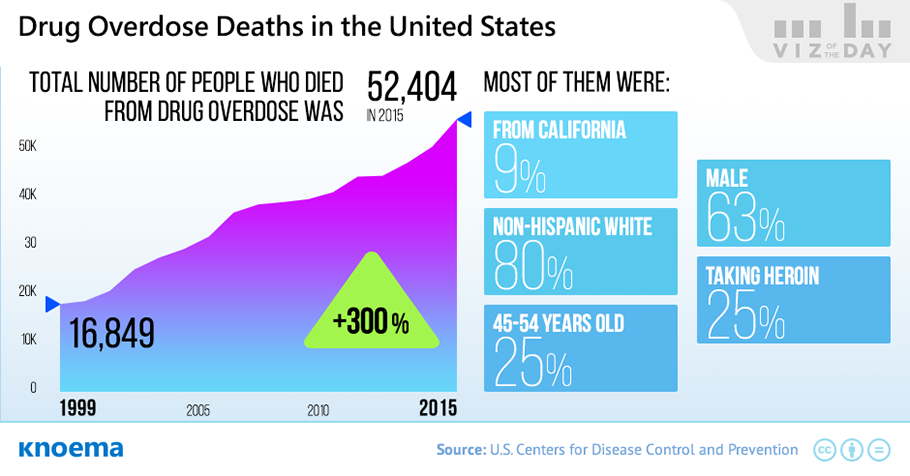Deaths by drug overdose have surged in the US in recent years, reaching what some call epidemic levels in select states and among certain segments of the US population. Drug overdose deaths in the United States have increased three-fold since 1999 from roughly 17,000 deaths to about 52,500 deaths in 2015, according to the US Centers for Disease Control and Prevention (CDC). Over the same period, the overdose death rate increased from 6 to 16 deaths per 100,000 people, which means that it grew at a much higher pace than did the US population. To put this further into perspective, the CDC data tell us that in 2015 more people died from drug overdoses in the United States than died from armed conflict in Africa.
- Among US states, the "leader" based on number of drug overdose deaths in 2015 was California with 4,659 deaths. Taking total population into account, however, California’s rate is almost four times lower than that of West Virginia, the state with the highest overdose-related death rate.
- Approximately half of all deaths were caused by an overdose of heroin and natural semi-synthetic opioids. This is particularly interesting given that the retail prices for heroin in the United States have increased considerably since 1999.
The growth in deaths from drug overdose is a significant public health burden in the United States. This burden disproportionately affects specific segments of the population, and these populations are shifting in some instances.
- The 2015 data shows that the number of overdose deaths among adults aged 45-54 years old exceeds that of other age groupings at 30 deaths per 100,000 people, however, the growth rate among younger age groups has accelerated since 2013.
- The non-Hispanic white population accounted for the vast majority of deaths from a drug overdose, accounting for 80 percent of the deaths. Moreover, from 1999 to 2015, the drug overdose death rate among this population increased from 6.2 to 21.1, an average annual rate of 7 percent.
- Other races—including black and Hispanic Americans—have historically seen a more tempered increase in the overdose death rate, but the most recent data from the CDC reveals potential shifts in these trends. For example, the number black Americans who died from a drug overdose increased in 2015 from 10.5 deaths per 100,000 people to 12.2 deaths, the largest single-year increase in drug-related deaths among this group in the last 16 years.
- While men have persistently represented the majority of deaths by drug overdose at around 60 percent, the increased deaths nationwide by drug overdose during 2015 took an even greater toll on men in the US. The annual growth rate in overdose deaths among men was an astonishing 14.4 percent from 2014 to 2015, with the total number of deaths climbing from nearly 29,000 to about 33,000.
Материалы по теме
Cocaine Prices
Although global coca bush cultivation in 2014 increased by 10 percent from the previous year, the actual area under coca bush cultivation was the second smallest since the late 1980s. Global cocaine manufacture was slightly higher than in the previous year but still 24-27 percent lower than the peak in 2007, and thus basically back to the levels reported in the late 1990s. At the same time, there are indications that the increase in global cocaine manufacture observed in 2014 was not a one-off event and may have continued in 2015.
World Drug Report
Today there is widespread recognition that drugs, together with organized crime, jeopardize the achievement of the Millennium Development Goals. It is increasingly clear that drug control must become an essential element of our joint efforts to achieve peace, security and development. The World Drug Report documents developments in global drug markets and tries to explain the factors that drive them. Its analysis of trends and emerging challenges informs national and international drug and crime priorities and policies, and provides a solid foundation of evidence for counternarcotics interventions. Drug markets and drug use patterns change...
Marijuana Use and Cannabis Industry Statistics
Beginning January 1 2014, establishments licensed by the state of Colorado began commercial sales of marijuana to the general public, leading cannabis industry stock values to skyrocket by about 150 percent. While the stock boom was over that same spring, according to Bloomberg, legal marijuana market was still the fastest growing industry in the US in 2014. As stated in the ArcView Market Research report, the US market for legal cannabis grew by 74 percent from $1.3 billion in 2013 to $2.7 billion in 2014 (see "Cannabis sales in 2014" chart below). According to the National Survey on Drug Use and Health, about 12 percent of the US...
Seven Big Summits: UN General Assembly Special Session on the World Drug Problem
Event date: April 19 - 21 Three weeks after the Nuclear Security Summit, the action will shift to New York, where the United Nations will hold its first special session on the global drug problem since 1998. Eighteen years ago, the slogan was “A Drug-Free World: We Can Do It.” Its focus was on prohibition, eradication, interdiction, prosecution, and incarceration. This year's summit will be different: frustrated by the futile “war on drugs” and its attendant criminal violence, a number of national governments (particularly in Latin America and Europe) are experimenting with decriminalization and harm-reduction strategies. In the United...
